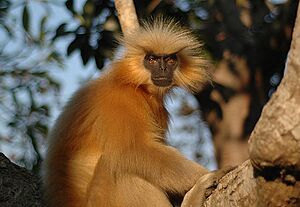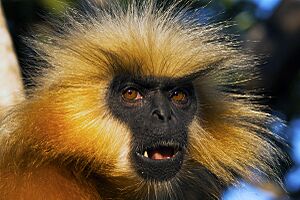Gee's golden langur facts for kids
Quick facts for kids Gee's golden langur |
|
|---|---|
 |
|
| Conservation status | |
| Scientific classification | |
| Genus: |
Trachypithecus
|
| Species: |
geei
|
| Subspecies | |
|
|
 |
|
| Gee's golden langur geographic range | |
The Gee's golden langur (Trachypithecus geei), also called the golden langur, is a type of Old World monkey. You can find it in a small part of Western Assam, India. It also lives in the nearby foothills of the Black Mountains in Bhutan.
Many people in the Himalayas have long thought of the golden langur as sacred. A naturalist named Edward Pritchard Gee first told the Western world about this monkey in the 1950s. Adult males have fur that is cream to golden in color. Their sides are a bit darker. Females and young langurs are lighter in color. The golden langur has a black face and a long tail. Its tail can be up to 50 centimeters (20 inches) long.
These monkeys live high up in trees. They are herbivores, meaning they eat plants. Their diet includes fruits, leaves, seeds, buds, and flowers. A typical group has about eight langurs. There are usually several females for every adult male. The golden langur is one of the most endangered primate species in India and Bhutan. In 2008-09, there were about 6,000 golden langurs in India. By 2020-21, this number had grown to 7,396.
Contents
How Was the Golden Langur Discovered?
People knew about the golden langur for a long time. The first written record of it was in 1838. Robert Boileau Pemberton wrote that someone saw these monkeys in Central Bhutan. However, his work was lost for many years.
The scientific discovery happened later. In 1907, Edward Oswald Shebbeare saw a "cream coloured langur." But he didn't have a photo or a specimen. In 1919, a publication mentioned a "pale yellow coloured langur" in Assam.
In 1947, C. G. Baron reported seeing langurs that were "light silvery-gold." A year later, H. E. Tyndale saw "Sankosh cream langurs." But it was Edward Pritchard Gee who made a big effort to find them. In 1953, Gee and his team saw three groups of golden langurs. They even made movies of one large group.
In 1954, Gee shared his findings with experts. They thought the golden langur might be a new species. In 1955, Gee showed his movies to the Zoological Survey of India (ZSI). They decided to study the area. In 1956, Dr. H. Khajuria studied the specimens they collected. He named the new species Presbystis geei, honoring Gee.
Types of Golden Langurs
There are two types, or subspecies, of the golden langur:
- Trachypithecus geei geei (discovered in 1956)
- Trachypithecus geei bhutanensis (discovered in 2003)
A natural break in the Himalayas separates these two types. T. g. bhutanensis lives in the northern part of Bhutan. T. g. geei is found in southern Bhutan and Assam, India.
Sometimes, golden langurs in Bhutan have bred with another type of monkey. This is the capped langur (T. pileatus). This might be happening because bridges were built across a river. This river used to keep the two species apart.
What Does a Golden Langur Look Like?
Adult golden langurs have fur that ranges from cream to golden. The fur on their sides and chest is darker, often a rusty color. Young langurs and females have lighter fur, from silvery-white to light buff. Their fur color changes with the seasons. It can be white or cream in summer and dark golden or chestnut in winter.
They have long whiskers that help protect their eyes from rain during the monsoon season. The golden langur has a black face. It also has a large swirl of hair on top of its head.
Male golden langurs are usually bigger and stronger than females. Adult males weigh about 10.8 kilograms (23.8 pounds). Adult females weigh around 9.5 kilograms (20.9 pounds). Their head and body length is about 50 to 75 centimeters (20-30 inches). Their tail is quite long, measuring 70 to 100 centimeters (28-39 inches).
Where Do Golden Langurs Live?
Gee's golden langur lives in an area of about 30,000 square kilometers (11,583 square miles). Much of this area is not suitable for them. Their home is bordered by rivers: the Brahmaputra River to the south, the Manas River to the east, and the Sankosh River to the west. To the north are the Black Mountains of Bhutan. These natural barriers helped them become a distinct species.
Their population is split into two main groups by a highway, National Highway 27. The northern group lives in the western part of Manas National Park. This group is larger, with about 5,566 langurs in 534 groups. The southern group lives south of the highway. This group has about 1,830 langurs in 173 groups. The Ripu Reserve Forest has the most langurs in the northern group. The Chakrashila Wildlife Sanctuary has the most in the southern group.
In 1988, some golden langurs that were raised in captivity were set free. This happened in Tripura state in north-eastern India. This area is not their natural home. One group, released into Sepahijala Wildlife Sanctuary, has survived and adapted to living in the wild.
How Do Golden Langurs Behave?
Golden langurs mostly stay in high trees. Their long tails help them balance when they jump between branches. During the rainy season, they get water from dew and rain on leaves.
They are herbivorous, meaning they eat plants. Their diet includes ripe and unripe fruits, mature and young leaves, seeds, buds, and flowers.
They usually live in groups, called troops, of about 8 langurs. In a troop, there are usually more females than males. The smallest group found had four langurs. The largest had 22. Most groups have only one adult male.
Why Are Golden Langurs Endangered?
Gee's golden langur is an endangered species. Its population is shrinking. Experts believe there are only about 6,000 to 6,500 adult golden langurs left. It is one of the most endangered primate species in India and Bhutan.
In India, most of the langurs (93%) live in protected forest areas. These include Chirang, Manas, and Ripu reserves. The rest live in smaller, separate areas. The population has dropped by more than 30% in the last 30 years. It is expected to keep declining.
Golden langurs are protected by law. They are listed in Appendix I of CITES. This means international trade of them is banned. They are also protected under the Wildlife Protection Act, 1972 of India. And they are protected by the Forest and Nature Conservation Act of Bhutan, 1995.
Helping Golden Langurs in India
On June 5, 2019, officials in Bongaigaon district in Assam started a project. They planted fruit trees like guava, mango, and blackberry. This was done to help the golden langurs in the Kakoijana reserved forest. The goal is to give them enough food so they don't have to leave the forest. Some langurs have died from electric shocks or road accidents while looking for food outside the forest.
In 1988, two groups of captive golden langurs were released in Tripura, India. By 2000, one group in the Sepahijala Wildlife Sanctuary had survived.
Sadly, many young langurs are dying. This shows that the population is declining. Human activities are damaging their homes. However, one group living in a rubber plantation in Assam actually grew. It went from 38 langurs in 1997 to 52 in 2002. These langurs have even learned to eat dry rubber seeds.
Images for kids





